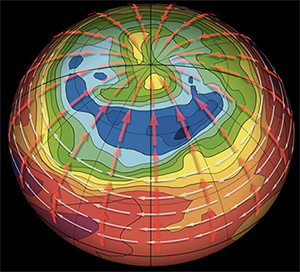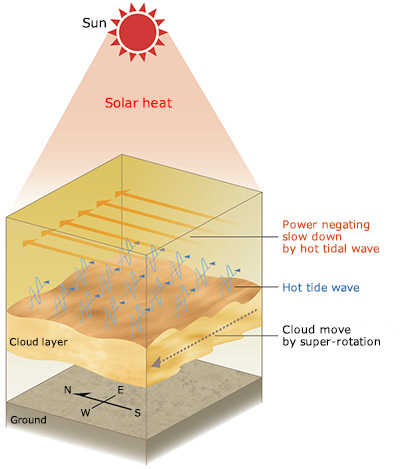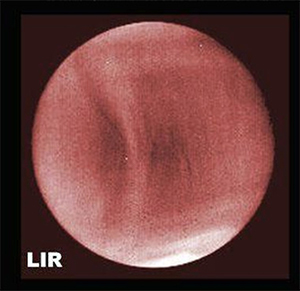Theoretical Elucidation of High-temperature
Formation/Sustenance Mechanism
in Venus Polar Region
February 1, 2016 (JST)
National Research and Development Agency
Japan Aerospace Exploration Agency (JAXA)
Keio University
Kyoto Sangyo University
A research team led by Hiroki Ando, Aerospace Project Research Associate of the Japan Aerospace Exploration Agency (JAXA), succeeded to theoretically clarify the formation and sustenance mechanism of the unique temperature distribution in the atmosphere over the polar region of Venus by reproducing such a distribution using a large-scale computer for the first in the world.

Image of temperature and atmosphere flow over Venus polar region |
In the 1970s, Venus probe missions found a mysterious temperature distribution of the high-temperature zone surrounded by the cold zone over the Venus polar region. However, the mechanism of how such a temperature distribution was formed and has been maintained for a long period had not been clarified until now. |
|---|
|
First, south-north atmospheric flows are generated due to heating of the Venusian cloud layer by solar light. These flows are accumulated over the Venusian polar region to become descending current. Atmospheric flows toward the lower altitude of high atmospheric pressure are condensed. One of the characters of a gas is that its temperature becomes higher when being condensed. The process of accumulating atmospheric flows in the polar region is related to a gigantic wave wrapping around Venus. The computer model indicates that a gigantic wave is a cause of continuous high temperature in some parts of the polar region. |

Image of excitation of the south-north circulation by hot tide wave |
|---|

Pseudo-color image of Venus by the Longwave IR camera (LIR) aboard the Venus Climate Orbiter “AKATSUKI” (Image taken on Dec. 7, 2015) |
The Venus Climate Orbiter “AKATSUKI” will start its full-scale observations in April 2016. When a multiple number of cameras aboard the AKATSUKI observe and show us the strength of the south-north atmosphere flows and the temperature distribution, the theoretical model in this research will be verified, and our understanding of the Venusian atmosphere and weather is expected to be further deepened by interpreting observation results using the model. |
|---|
Publication source
Magazine: Nature Communications (Dated Feb. 1, 2016)
Thesis title: The puzzling Venusian polar atmospheric structure reproduced by a general circulation model
| Authors: | Hiroki Ando, JAXA |
|---|---|
| Norihiko Sugimoto, Keio University | |
| Masahiro Takagi, Kyoto Sangyo University | |
| Hiroki Kashimura, Japan Agency for Marine-Earth Science and Technology | |
| Takeshi Imamura, JAXA | |
| Yoshihisa Matsuda, Tokyo Gakugei University |
DOI No.: 10.1038/NCOMMS10398